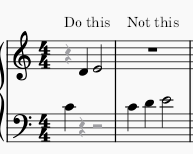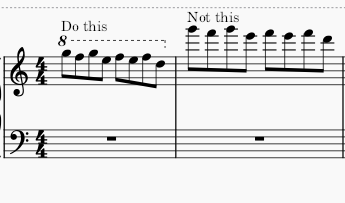When should you use ledger lines on the harp? This is a common question I often discuss with composers. If you’ve ever wondered about this, make sure to bookmark this blog post for future reference!
Table of Contents
Use ledger lines intentionally
When should you use ledger lines in harp music? The approach is similar to writing for piano.
Rule 1
Avoid using more than 1-2 ledger lines between the staves. (See splitting hands by register rather than by staff.) For example, if you’re writing an E above middle C, it should typically be placed on the treble staff, not the bass. An exception might be if the top staff is 8va or if using a ledger line better preserves the musical line and direction of the notes (see Rule 3).
(Note: The grey rests would be hidden in the final score.)

Rule 2
Minimize the use of more than 3 ledger lines above the treble clef or below the bass clef. Unlike flutists, harpists are generally less comfortable reading extensive sections with numerous ledger lines. If a passage requires 3 or more ledger lines for an extended period, it’s better to use the 8va sign.

Exceptions to Rule 2
Octaves, especially in the bass clef, can extend beyond this range if the upper note remains on the staff. However, this exception doesn’t apply to non-octave intervals.
Rule 3
Preserve the musical line. If using 8va/8vb obscures the flow of the music, a few ledger lines may be necessary for occasional high or low notes, or as a temporary solution before transitioning to 8va/8vb. In the second example below, the line visually appears to descend from the high G, even though it’s actually leaping upward.
Summary
If you’re unsure about using ledger lines, start by writing the notes at pitch. Then, if you notice extended passages with 3 or more ledger lines, or multiple ledger lines (more than 1) between the staves, go back and make adjustments. While doing so, keep Rule 3 in mind—using a few ledger lines is less confusing than creating visually contradictory intervals.
Got Questions?
Do you have questions or other thoughts about this post? Leave a comment!
Stay Connected
Sign up for the Harp Tips Emails for more harp writing strategies and resources, plus a subscriber-exclusive Q&A.
Danielle Kuntz is a new music harpist and harp notation coach for composers. Learn more about her work at daniellekuntz.com.
